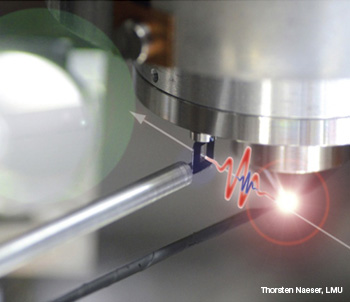
The electronic properties of silica changed from an insulator to a conductor when hit with an intense femtosecond laser pulse. When a thin silica-glass film (black frame in the center) is exposed to ultrafast light pulses (red), the strong optical field changes the electronic states in the glass with each cycle of its oscillation. These variations were tracked in real time by a series of "snapshots" recorded by attosecond light pulses (blue) passed through the sample. The recording of the instantaneous state of the electronic system of the probed sample allows researchers to reconstruct the field-induced changes.
Usually, if you blast enough light into an insulator, it will blow up quickly or break down slowly. But today, a pair of papers published in Nature describe using very intense femtosecond laser pulses that not only do not damage the material, but also induce electrical currents in an otherwise insulating dielectric—specifically a fused silica prism (Nature, DOI: 10.1038/nature11567; Nature, Advanced DOI: 10.1038/nature11720).
The work is exciting because insulators that can quickly change into conductors (and back into insulators again) could be used for signal switching. Today's fastest semiconductor switching is measured in terahertz, but light-induced switching in insulators, such as demonstrated in these papers, could work at petahertz rates—more than 10,000 times the rate of current electronics. In the near-term, it could also make possible petahertz metrology.
The team, led by Ferenc Krausz's group at the Max Planck Institute of Quantum Optics (Germany), with researchers at Germany’s Ludwig Maximilians University Munich and Technical University Munich, as well as Mark Stockman's theoretical group at Georgia State University (U.S.A.), first investigated whether a small silica-glass prism could conduct current when hit with a few-cycle femtosecond pulse. They used a Ti:sapphire chirped pulse amplifier to produce wideband visible/IR pulses with an energy of about 400 microJ in a pulse shorter than 4 femtoseconds. After the pulse hit the prism, a second, weaker pulse induced a current, measured between two sides of the prism that were coated with gold electrodes. Varying the time between pulses resulted in changes in the direction of the induced current. Researcher Tim Paasch-Colberg explains, "This behavior is a strong indication that the material is turned from an insulator into a conductor by the strong light field within less than a femtosecond." He adds, "However, from these observations we cannot yet conclude that the conductivity can also be switched off within the same time scale," which is a requirement for signal processing.
The second experiment tackled the turn-off speed. A thin film of silica was exposed to the same pulses (see image). The extremely fast variations of the electric properties caused by the strong field were tracked in real time with time-resolved extreme UV absorption spectroscopy, which probed the thin film with UV light pulses shorter than 100 attoseconds (a thousand times shorter than a femtosecond). "Our results show that the field-induced changes follow, in a highly nonlinear fashion, both the turn-on and the turn-off behavior of the driving laser field," explains Elisabeth Bothschafter, "and thus, they clearly point to the reversibility of the field-induced effects."
